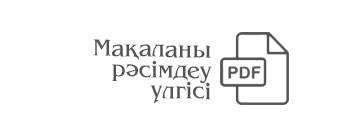ТУРИСТІК МАРКЕТИНГТЕ ТОЛЫҚТЫРЫЛҒАН ШЫНДЫҚТЫ (AR) ЖӘНЕ ВИРТУАЛДЫ ШЫНДЫҚТЫ (VR) ПАЙДАЛАНУ
DOI:
https://doi.org/10.55956/XRLV7458Тірек сөздер:
толықтырылған шындық, виртуалды шындық, туристік маркетинг, қонақ үй, мейрамханаАңдатпа
азіргі технологиялық жетістіктер тұлғааралық қарым-қатынас және коммуникация динамикасын өзгертіп, компаниялар мен тұтынушылар арасындағы өзара әрекеттесудің жаңа жолдарын жасады. Виртуалды Шындық (VR) және Толықтырылған Шындық (AR) жеке тұлғаларға осы дамып келе жатқан технологияларға бейімделу үшін инновациялық құралдарды ұсынады.Туризм және туризм индустриясы осы иммерсивті технологияларды ерекше қолданды. Бұл зерттеу Түркиядағы және дүние жүзіндегі қонақүйлер, мейрамханалар, қолданбалар және туристік провайдерлер сияқты әртүрлі секторлардан ақпарат ала отырып, Туристік маркетингтегі AR және VR қолданбаларын дербес зерттеуге бағытталған. Әдебиеттерді жан-жақты шолу арқылы зерттеу негізгі ұғымдарды түсіндіреді. Екі кейс, Dedeman Istanbul Hotel Және Marriott International Hotels, жағдайлық зерттеулерді талдауға бағытталған сапалы зерттеу тәсілін қолдана отырып зерттелді. Саяхатты ілгерілетудегі AR және VR технологияларының тиімділігі бағаланды. Индуктивті пайымдау арқылы талданған осы таңдалған тақырыптар зерттеулер туристік маркетингте AR және VR технологияларын әртүрлі және тиімді пайдалануды көрсетуге қызмет етеді.
Библиографиялық сілтемелер
1. Chao, C. N., Corus, C., & Li, T. (2012). Balancing traditional media and online advertising strategy. International Journal of Business, Marketing, and Decision Sciences, 5(2), 12-25.
2. Buhalis, D. and Egger, R. (2006), “Informations- und kommunikationstechnologien als mittel zur prozess- und produktinnovation fu¨r den unternehmer”, in Peters, M. and Pikkemaat, B. (Eds), Innovationen im Tourismus, Dt. Ges. f. Tourismuswissen, Berlin, pp. 163-176.
3. Subawa, N. S., Widhiasthini, N. W., Astawa, I. P., Dwiatmadja, C., & Permatasari, N. P. I. (2021). The practices of virtual reality marketing in the tourism sector, a case study of Bali, Indonesia. Current Issues in Tourism, 24(23), 3284-3295.
4. Van Krevelen, D. W. F., & Poelman, R. (2010). A survey of augmented reality technologies, applications and limitations. International journal of virtual reality, 9(2), 1-20.
5. Buhalis, D. (2000). Marketing the competitive destination of the future. Tourism management, 21(1), 97-116.
6. Buhalis, D., & Law, R. (2008). Progress in information technology and tourism management: 20 years on and 10 years after the Internet—The state of eTourism research. Tourism management, 29(4), 609-623.
7. Statista. (2024). “Number of Virtual Reality (VR) and Augmented Reality (AR) Users” Accessed on 26.12.2023. https://www.statista.com/topics/3286/augmented-reality-ar/#topicOverview
8. Loureiro, S. M. C., Guerreiro, J., & Ali, F. (2020). 20 years of research on virtual reality and augmented reality in tourism context: A text-mining approach. Tourism management, 77, 104028.
9. Gajdošík, T. (2018). Smart tourism: Concepts And Insights From Central Europe. Czech Journal Of Tourism. 7(1),25-44.
10. Harrison, C., Eckman, B., Hamilton, R., Hartswick, P., Kalagnanam, J., Paraszczak, J. ve Williams, P. (2010). Foundations For Smarter Cities. IBM Journal of Research and Development, 54(4), 1-16.
11. Cohen, E. (1979). A phenomenology of tourist experiences. Sociology, 13(2), 179-201.
12. Jeong, M., & Shin, H. H. (2020). Tourists’ experiences with smart tourism technology at smart destinations and their behavior intentions. Journal of Travel Research, 59(8), 1464-1477.
13. Gretzel, U., Sigala, M., Xiang, Z., & Koo, C. (2015). Smart tourism: foundations and developments. Electronic markets, 25, 179-188.
14. Buhalis, D., & Amaranggana, A. (2013). Smart tourism destinations. In Information and Communication Technologies in Tourism 2014: Proceedings of the International Conference in Dublin, Ireland, January 21-24, 2014 (pp. 553-564). Springer International Publishing.
15. Dalkiran, G. B. (2022). The effects of industry 4.0 components on the tourism sector. Logistics 4.0 and Future of Supply Chains, 235-250.
16. Koo, C., Shin, S., Kim, K., Kim, C., & Chung, N. (2013). Smart Tourism of the Korea: A Case Study. PACIS 2013 Proceedings
17. Savić, J. ve Pavlović, G. (2018). Analysis of factors of smart tourism development inSerbia. Hotel and Tourism Management, 6(1), 81-91.
18. Buhalis, D. (2019). Technology in tourism-from information communication technologies to eTourism and smart tourism towards ambient intelligence tourism: A perspective article. Tourism Review. 75(1), 267–272.
19. Guttentag, D. A. (2010). Virtual reality: Applications and implications for tourism. Tourism management, 31(5), 637-651.
20. Adachi, R., Cramer, E. M., & Song, H. (2022). Using virtual reality for tourism marketing: A mediating role of self-presence. The Social Science Journal, 59(4), 657-670.
21. Akpınar, Y. (1999). Bilgisayar destekli öğretim ve uygulamalar. Ankara: Anı Yayıncılık.
22. Burdea, G. ve Coiffet, P. (2003). Virtual reality technology. (2). New York: John Wiley and Sons, Inc.
23. Strategic Direction. (2016). A new democracy for new media: challenges to traditional media and adapting to modern consumers", Strategic Direction (online), 32(11): 7-9. Available: https://www.emerald.com/insight/content/doi/10.1108/SD-08-2016-0123/full/html (Accessed 26.12.2023).
24. Linowes, J. (2018). Unity virtual reality projects: Learn virtual reality by developing more than 10 engaging projects with unity. (2). Birmingham: Packt Publishing Ltd.
25. Gutiérrez, M., Vexo, F. ve Thalmann, D. (2008). Stepping into virtual reality. London: Springer.
26. Sherman, W. R. ve Craig A. B. (2003). Understanding virtual reality, Elsevier Science, USA.
27. Virtualspeech, (2023), https://virtualspeech.com/blog/history-of-vr, accessed in 31.12.2023.
28. Bimber, Oliver and Raskar, Ramesh. (2005). Spatial Augmented Reality: Merging Real and Virtual Worlds. Massachusetts: AK Peters/CRC.
29. Milgram, P., Zhai, S., Drascic, D., & Grodski, J. (1993, July). Applications of augmented reality for human-robot communication. In Proceedings of 1993 IEEE/RSJ International Conference on Intelligent Robots and Systems (IROS’93) (Vol. 3, pp. 1467-1472). IEEE.
30. Tang, S. L., Kwoh, C. K., Teo, M. Y., Sing, N. W., & Ling, K. V. (1998). Augmented reality systems for medical applications. IEEE engineering in medicine and biology magazine, 17(3), 49-58.
31. Berryman, D. R. (2012). Augmented reality: a review. Medical reference services quarterly, 31(2), 212-218.
32. Regenbrecht, H., Baratoff, G., & Wilke, W. (2005). Augmented reality projects in the automotive and aerospace industries. IEEE computer graphics and applications, 25(6), 48-56.
33. Livingston, M. A., Rosenblum, L. J., Brown, D. G., Schmidt, G. S., Julier, S. J., Baillot, Y. Baillot, J. Swan, Z. Ai, and P. Maassel (2011). Military applications of augmented reality. Handbook of augmented reality, 671-706.
34. Yung, R., & Khoo-Lattimore, C. (2019). New realities: a systematic literature review on virtual reality and augmented reality in tourism research. Current issues in tourism, 22(17), 2056-2081.
35. Reis, J. L., Peter, M. K., Cayolla, R., & Bogdanovic, Z. (2021). Marketing and smart technologies. Proceedings of ICMarkTech, 1.
36. Cranmer, E. E., tom Dieck, M. C., & Fountoulaki, P. (2020). Exploring the value of augmented reality for tourism. Tourism Management Perspectives, 35, 100672.
37. Karaman, A., Şimşek, G. ve Karaman, E. E. (2019). Akıllı Otel İşletmeciliği Ve Turizm 4.0. A. Karaman & K. Sayın (Eds.). Dijital Turizm Sektörünün Yeni Geleceği. Konya: Eğitim Yayınevi
38. Özbek, Ö. ve Ünüsan, Ç. (2018). Artırılmış gerçeklik uygulamalarının destinasyon pazarlamasında incelenmesi: Seyahat acentaları ile ilgili bir araştırma. Journal of International Social Research, 11(59), 1033-1047.
39. Cankül, D., Doğan, A. ve Sönmez, B. (2018). Yiyecek-içecek işletmelerinde inovasyon ve artırılmış gerçeklik uygulamaları. İşletme Araştırmaları Dergisi, 10(3), 576-591.
40. Pavlov D. (2024). Examples of How AR Can Be Used in Restaurants and Bars, https://smarttek.solutions/blog/ar-for-restaurants, Accessed on 06.01.2024.
41. Yıldırım, A. ve Şimşek, H. (2008), Sosyal Bilimlerde Nitel Araştırma Yöntemleri (6. Baskı), Ankara: Seçkin Yayıncılık.
42. Creswell, J. W. (2007), Qualitative Inquiry & Research Design – Choosing Among Five Approaches, 2nd ed., SAGE Publications: Thousand Oaks, California
43. Martins, L. M. (2017). Augmented Reality in Hotels Use Case - Holiday Inn, the first ever. https://www.linkedin.com/pulse/augmented-reality-hotels-use-case-holiday-inn-first-lu%C3%ADs,Accessed in 06.01.2024
44. Todorović, V., Milić, N., & Lazarević, M. (2019). Augmented Reality in Food production traceability–use case. In IEEE EUROCON 2019-18th International Conference on Smart Technologies (pp. 1-5). IEEE.
45. Costin, H., & Eslava, A. (2022). Emerging Technology Trends in Hospitality and Tourism. University of South Florida (USF) M3 Publishing, 17(9781732127593), 11.
46. Rhodes, G. A. (2015). Future museums now—augmented reality musings. Public Art Dialogue, 5(1), 59-79.
47. Hui, L., Hung, F. Y., Chien, Y. L., Tsai, W. T., & Shie, J. J. (2014, July). Mobile augmented reality of tourism-Yilan hot spring. In 2014 7th International Conference on Ubi-Media Computing and Workshops (pp. 209-214). IEEE.
48. Higgins-Desbiolles, F. (2018). Event tourism and event imposition: A critical case study from Kangaroo Island, South Australia. Tourism Management, 64, 73-86.
49. Mofokeng, N. E. M., & Matima, T. K. (2018). Future tourism trends: Virtual reality based tourism utilizing distributed ledger technologies. African Journal of Hospitality, Tourism and Leisure, 7(3), 1-14.
50. Acir, E. (2019), Video games, virtual reality and augmented reality applications in tourism promotion and marketing. In 9th Advances in hospitality and tourism marketing and management conference proceedings.
51. Brinkman, H. R. (2020). Videogame Tourism: Spawning the Digital into the Physical Realm in the British Isles (Doctoral dissertation, The University of Wisconsin-Milwaukee).
52. Laukkanen, E., & Johansson, K. (2017). Comparing the Effects of a 2D Video to a Multisensory Video on a Destination Image–Case Study of Dubai.
53. Lekgau, R. J., Harilal, V., & Feni, A. (2021). Reimagining tourism: COVID-19 and the potential of virtual tourism in South Africa. African Journal of Hospitality, Tourism and Leisure, 10(4), 1516-1532.
54. Hudson, S., & Li, J. (2018). Destination branding. C. Cooper, S. Volo, WC Garta ner (eds.) The Sage Handbook of Tourism Management, 219-236.
55. Taylor, M. (2018). Marriott Launches Augmented Reality App. Tech Pulse. Available.
56. Bharwani, S., & Mathews, D. (2021). Techno-business strategies for enhancing guest experience in luxury hotels: a managerial perspective. Worldwide Hospitality and Tourism Themes, 13(2), 168-185.
57. Ferrandez, C. (2024). Augmented reality restaurant experiences: 5 examples (2024) https://poplar.studio/blog/augmented-reality-restaurant-experiences-5-examples, Accessed on 06.01.2024


